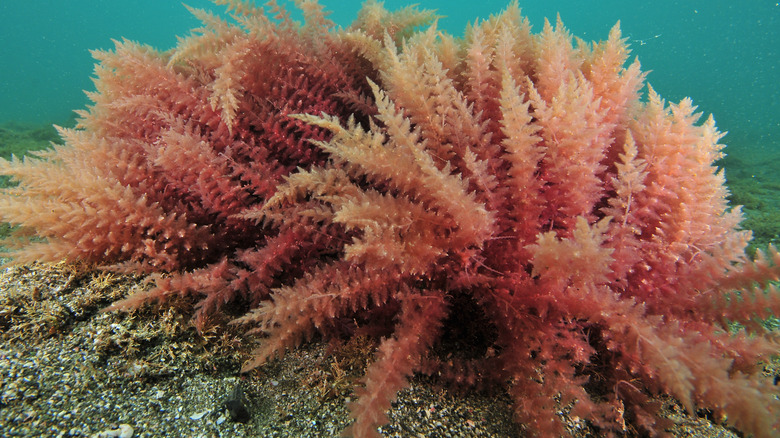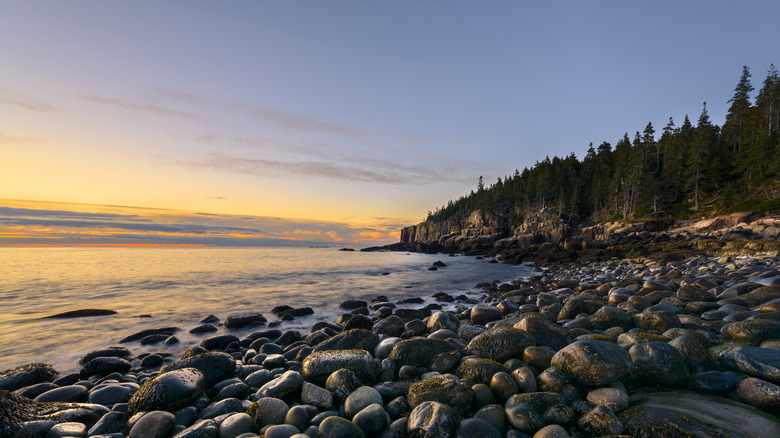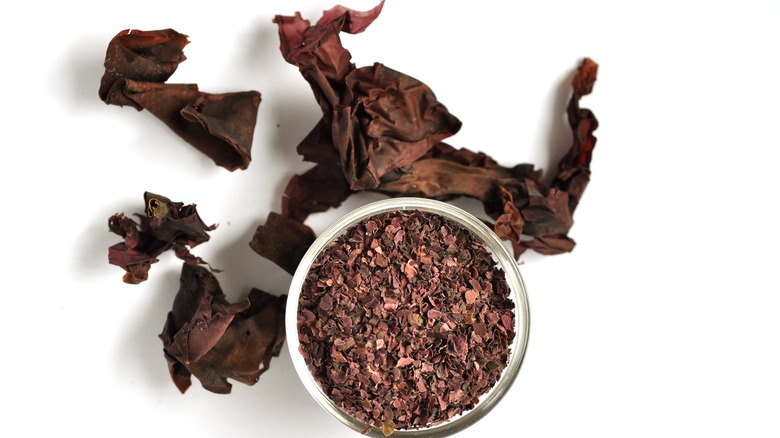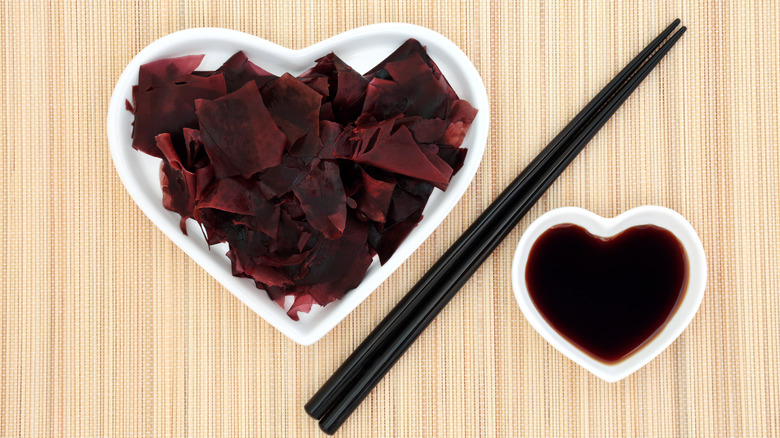Dulse: The Mineral-Rich Sea Veggie That Tastes A Lot Like Bacon
The Smithsonian's Ocean Portal, an educational platform that is a part of the Smithsonian Institution's Ocean Initiative, defines sea vegetables as the edible plants and algae that grow in or around the ocean. For thousands of years, coastal communities — particularly in Asian nations like Japan and China, the Polynesians, Nordic countries, and the Caribbean — have included salty seaweeds in their diets. Dulse, scientifically known as Palmaria palmata, belongs to the family of red seaweeds, per Sea Veg, and is famous for its crimson, purplish, and red-brown color.
The consumption of dulse by Europeans dates as far back as 563 AD when it was a particularly valued food source in Iceland. Since then, dulse has been referenced as a source of food and medicine in many northern European texts. While seaweed has remained popular in many eastern cultures, the tradition of eating it largely disappeared during the 1900s as the western diet became more widespread (Sea Veg). Today, however, many types of seaweed are having a comeback. According to Bon Appétit, researchers bet that everyone will be eating dulse — because it tastes like bacon.
Where and how it's made
Rooted in the Latin word for hand, "palma," dulse's scientific name emphasizes the sea plant's hand-like shape, per Sea Veg. All along the European and North American coast, dulse grows wild — beginning as a single, flat frond that divides into segments that resemble fingers. However, only a few places in the world, including Ireland, Spain, Iceland, and the Bay of Fundy in the northernmost Gulf of Maine, have the right combination of conditions dulse needs (via Sea Veg). And even with the right kinds of tides, waves, and rocky sediment, the tradition of hand-harvesting dulse is a challenge.
Because dulse grows along rocky beaches, it can't be harvested by boat, hand rakes, or mechanical devices. So, when the tides are at their lowest, dulse harvesters forage across slippery boulders to collect dulse the same way it has been for hundreds of years: by hand. Found low in the intertidal zone, the harvesters only have a couple of hours to collect the dulse before the tides rise back up and submerge the seaweed beds. Once the sea vegetable has been harvested, the dulse is transported inland to be solar-dried — meaning that harvest doesn't only have to be timed with the tide, but the sunshine too.
While farmers may one day be able to grow dulse in tanks — Bon Appetit mentions a patented strain being developed for this particular reason — these factors are why Sea Veg tells customers there may not always be as much dulse available as they'd like.
How to eat it
Among seaweed connoisseurs, dulse is thought to be one of the most mouthwatering. Even though dulse can be eaten raw, the drying process actually develops the sea veggie's more complex flavors over time (via Sea Veg). Dried dulse is described as having a mild, ocean-like flavor and savory, smokey essence. Its slight saltiness is often used as a seasoning to flavor simple dishes like eggs, potatoes, and popcorn, per The Ocean Portal. Dried dulse flakes can also be added to bread recipes or eaten on the go as a snack food.
However, Jason Ball, a research chef that works extensively with dulse, told Bon Appetit that when raw, whole-leaf dulse is pan-fried, "it takes on a lot of those smoky and savory characteristics that are very, very similar to bacon." According to Sea Veg, dulse's smoky flavors are only enhanced as it becomes crispy on the pan — which has led to its comparisons to bacon, and could be why some brands like Umaro Foods, which uses a blend of red seaweed in their plant-based bacon, found that kelp makes such a great meat substitute.
Nutrition and benefits
Like all sea vegetables, dulse has an impressive nutrition profile. Per Bon Appetit, dulse is packed with fiber, protein, healthy fatty acids, and vitamins and minerals. On average, Sea Veg claims that it contains 13% protein — however, depending on the season and harvest location, it can contain up to 30%. With all nine essential amino acids, dulse is a source of high-quality, complete protein. It's also a valuable source of iron, along with other minerals like potassium and a plethora of vitamins such as B1, 2, 3, and 9, vitamin A, vitamin E, and vitamin C.
In addition to its health benefits, dulse is a part of a vitally important food group known as "blue foods" (via Blue Food Assessment). Being a sea vegetable, dulse isn't just good for the environment — producing fewer greenhouse gas emissions than land-based crops and livestock while absorbing carbon dioxide from the atmosphere and de-acidifying our oceans (via Smithsonian Magazine) — but it's also a key element in the United Nations' goals of repairing the global food supply system.
In the face of increased food instability due to climate change, and a future in which there will be an even greater population to feed per Future Learn, the responsible cultivation of dulse and other blue foods will be the foundation of a food system that's diverse, equitable, and sustainable.
Where to get it
Much like other seaweeds like suji aanori and the sustainable caviar alternative, umi-budō, dulse has a short shelf-life that requires it to be dried within a few days of harvest (per Sea Veg). According to Bon Appetit, if you don't personally know someone who harvests dulse, it's unlikely you'll be able to get your hands on a raw batch. This is sad news if you were hoping to use the fresh leaves to experiment with making dulse bacon at home. However, Chris Langdon, a professor at Oregon State University, grows a patented strain of dulse in tanks which you may be able to find at restaurants or in plant-based meat substitutes (via 1859 Oregon Magazine).
On the other hand, dulse is equally as good for you when it's dried — with more developed and complex flavors as well. Plus, it's much easier to get your hands on. You can find dried dulse in the form of leaves, powders, flakes, and seasoning mixes at online retailers like Maine Coast Sea Vegetables and even at stores like Whole Foods Market.




